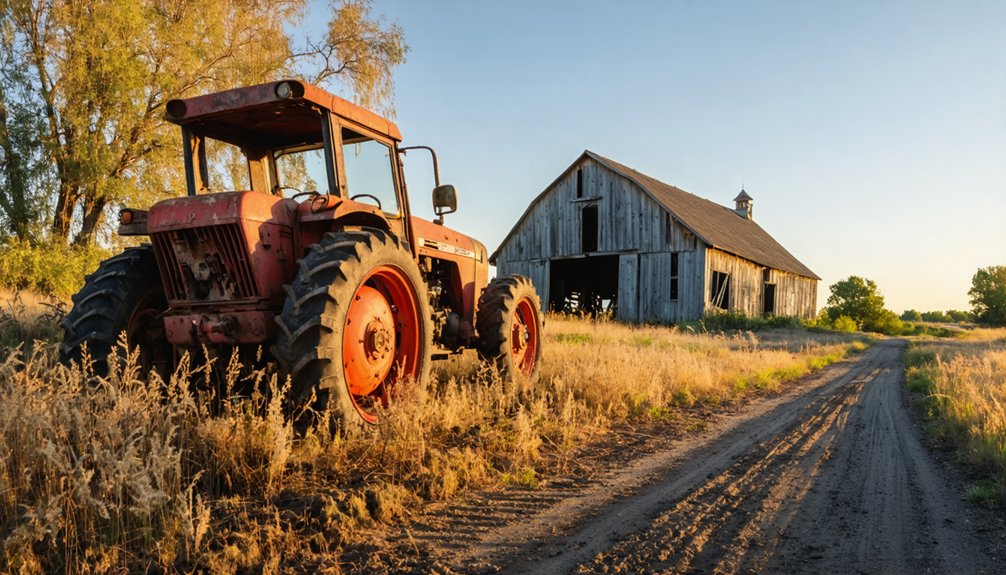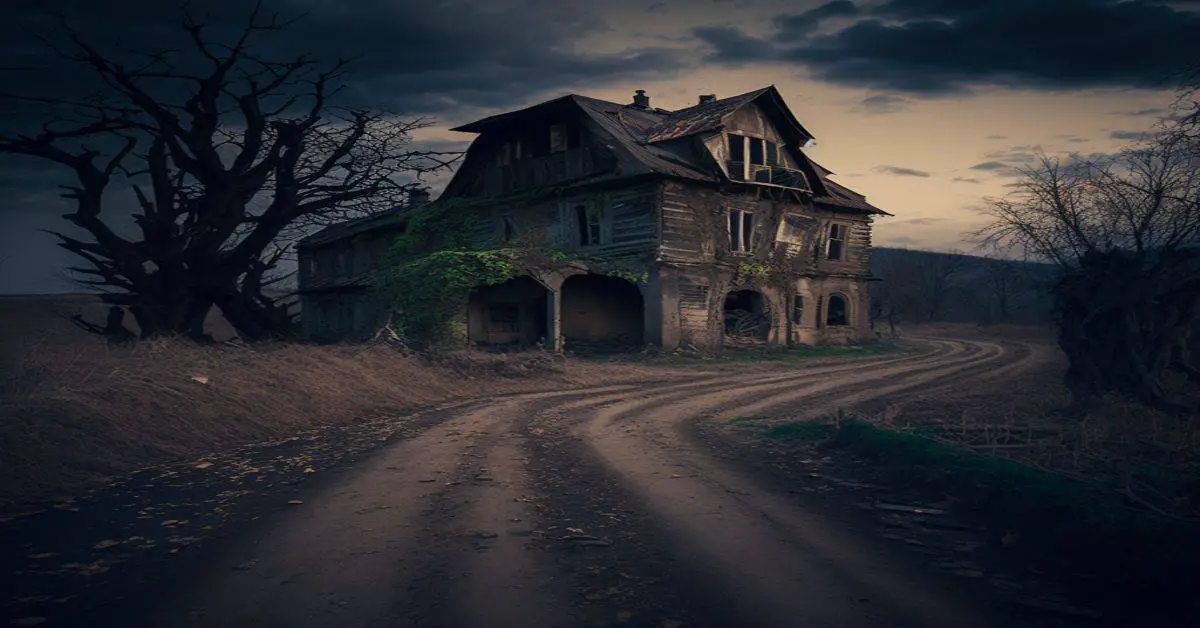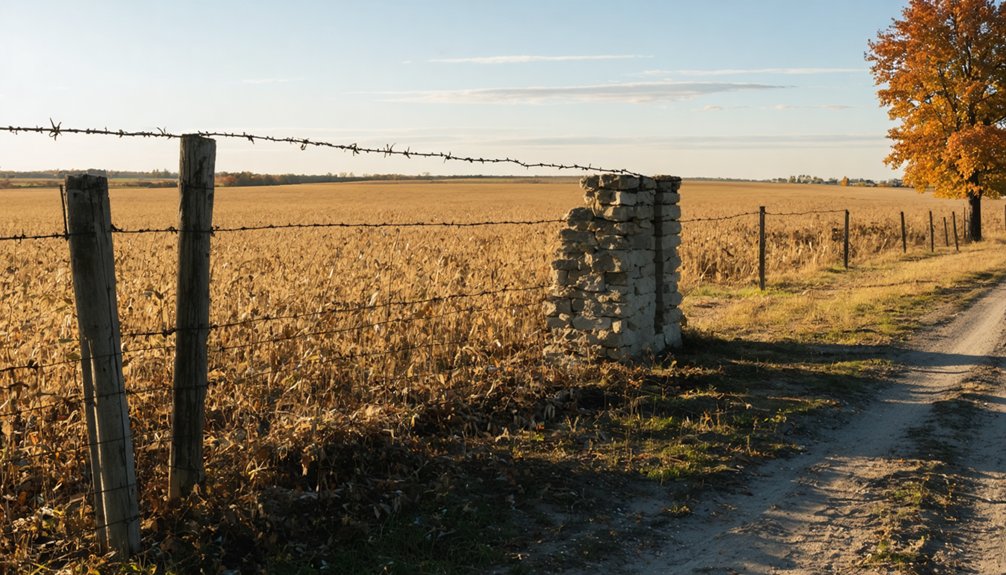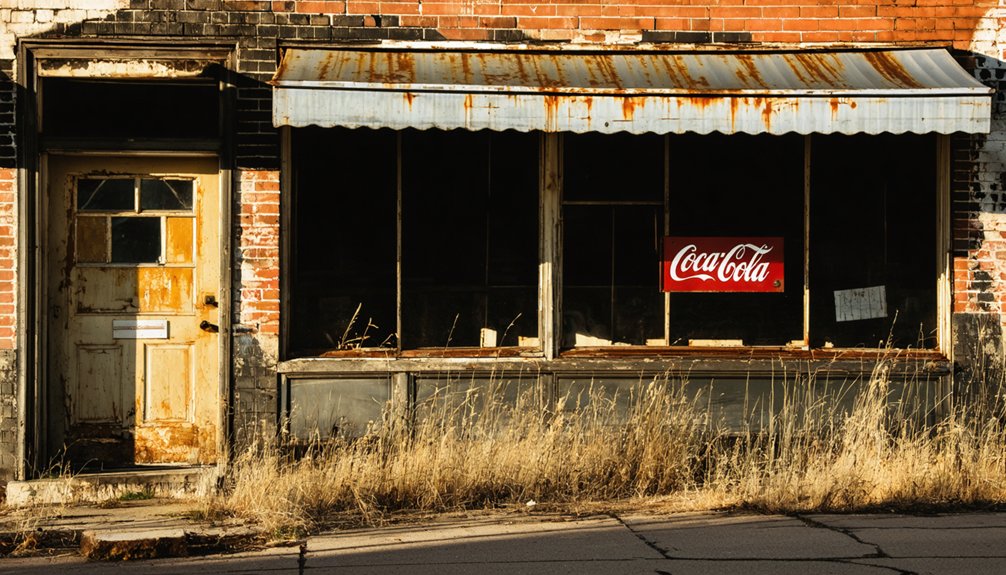You’ll find Horace, Illinois – a vanished rural hamlet – less than a mile west of Illinois Route 1 and about 5 miles north of Paris. Once a thriving agricultural community, it supported local farmers with a mercantile store and Baptist church. Today, Edgar County Airport occupies most of the former townsite, though you can still spot the weathered brick mercantile building nearby. The story of Horace mirrors many small Midwestern communities that faded into memory.
Key Takeaways
- Horace was a farming hamlet in Edgar County, Illinois, located 0.8 miles west of IL Route 1 and 5 miles north of Paris.
- The town’s most notable remaining structure is a brick mercantile building, with other structures now reduced to scattered concrete foundations.
- Edgar County Airport currently occupies the former town site, erasing most physical evidence of the original community’s existence.
- The town declined due to agricultural mechanization, rural exodus, and young residents migrating to urban areas for better opportunities.
- Daily life centered around 120-180 acre family farms, with the community supported by local trade, traveling craftsmen, and church gatherings.
The Elusive Settlement: Unraveling Horace’s Location
While many ghost towns in Illinois have faded into obscurity, Horace’s location remains surprisingly accessible, situated just 0.8 miles west of IL Route 1 and approximately 5 miles north of Paris.
You’ll find this hidden history nestled in a region characterized by agricultural landscapes and 2WD grid roads that make exploration straightforward in any season. Similar to Hancock County’s Capernaum site, many original residences still exist on their historical locations.
Despite its geographic significance as a former farming hamlet, you might encounter some confusion when researching Horace, as it’s occasionally misidentified as “Harris” on Illinois maps.
Don’t let this deter you – the site’s most prominent landmark, an old brick mercantile building, serves as your beacon to this lost settlement. This historical merchant building stands as the most significant architectural remnant of the town’s past.
The surrounding farmland and scattered abandoned structures tell the story of a once-thriving small community.
From Farmland to Ghost Town: A Historical Timeline
Before Horace transformed into the ghost town you’ll find today, it emerged as a modest farming hamlet in Edgar County, establishing itself through agricultural enterprise and local commerce.
You’ll discover its rural heritage reflected in the old brick mercantile building that still stands, while the Horace Baptist Church once served as the community’s spiritual center.
The town’s fortunes were initially bolstered by its strategic location near Illinois Route 1 and railway connections, which facilitated trade and transportation. The town’s name has been inaccurately shown as Harris on Illinois maps.
Like the historic town of Vishnu Springs, Horace became another example of how shifting economic conditions could transform a once-thriving community into abandoned land.
However, like many small farming communities, Horace couldn’t withstand the economic shifts and rural exodus of the 20th century.
Economic forces and population shifts of the 1900s spelled doom for countless farming towns like Horace, leading to their eventual abandonment.
The settlement gradually declined until it faded away, with its former location now occupied by the Edgar County Airport.
Surviving Structures and Physical Evidence
As you explore Horace today, you’ll find a lone brick mercantile building standing as the most prominent reminder of the town’s commercial past.
Around the former townsite, concrete foundations peek through tall grass, marking where homes and farm buildings once stood. Like the abandoned old Chevy dealership with its deteriorating roof in Buda, these remnants show the inevitable decay of time. Nature has steadily reclaimed abandoned lots throughout the area.
The town’s former airport strip has transformed into agricultural land, though its rectangular outline remains visible from aerial views.
Brick Mercantile Building Remains
The brick mercantile building stands as the most prominent survivor of Horace’s bygone era, located approximately one mile west of Illinois Route 1 and five miles north of Paris, Illinois.
This enduring structure, with its distinctive mercantile architecture, once served as the commercial heart of this small farming community. Like many rural crossroads settlements, the town developed primarily around agricultural and commercial opportunities. Historic topographic maps from 1947 show the layout of this once-bustling commercial district.
You’ll find the building’s brick masonry has weathered better than the wooden structures that once surrounded it, though it’s now showing signs of extensive deterioration.
Window and door openings remain visible but deteriorated, and parts of the roof may have collapsed.
While other abandoned buildings and scattered foundations dot the overgrown landscape near the Edgar County Airport, none match the mercantile’s community significance as the last substantial reminder of Horace’s commercial past.
Rural Building Foundations
Beyond the prominent brick mercantile building, scattered foundations throughout Horace tell a deeper story of rural life and abandonment.
You’ll find stone and concrete footings where homes once stood, their classic midwestern architectural styles still hinted at through partial porch remnants and cellar entrances. Nature’s determined reclamation has draped these sites in vines and vegetation, though foundation preservation varies across the landscape. Yellow spring daffodils bloom around many abandoned home sites, a persistent reminder of former gardens.
Agricultural remnants dot the periphery, where concrete piers and pads mark the locations of former barns and silos.
You might spot rusted hardware or old fence fragments near these farmstead foundations. The foundations of community buildings – churches and schools – survive as low stone walls and concrete slabs, helping you trace the town’s former social centers along the old roadbeds that still crisscross the site.
Airport Site Transformation
Located where Edgar County Airport now operates, Horace’s physical remnants have largely vanished beneath modern runways and taxiways.
You’ll find the most notable survivor – an old brick mercantile building – standing as a lonely sentinel near the airport grounds, while a few scattered abandoned structures dot the periphery.
Like the original dirt airstrip at Robbins Airport, the airport evolution has completely transformed this once-rural community.
You won’t see any trace of the original town roads, church foundations, or residential footprints that once defined Horace.
The community transformation has been thorough – modern airport infrastructure has erased nearly all evidence of the farming settlement through extensive grading and paving.
What you’re looking at today is primarily post-town development, with the airport’s contemporary needs taking precedence over preserving historic elements.
Daily Life in a Rural Illinois Hamlet
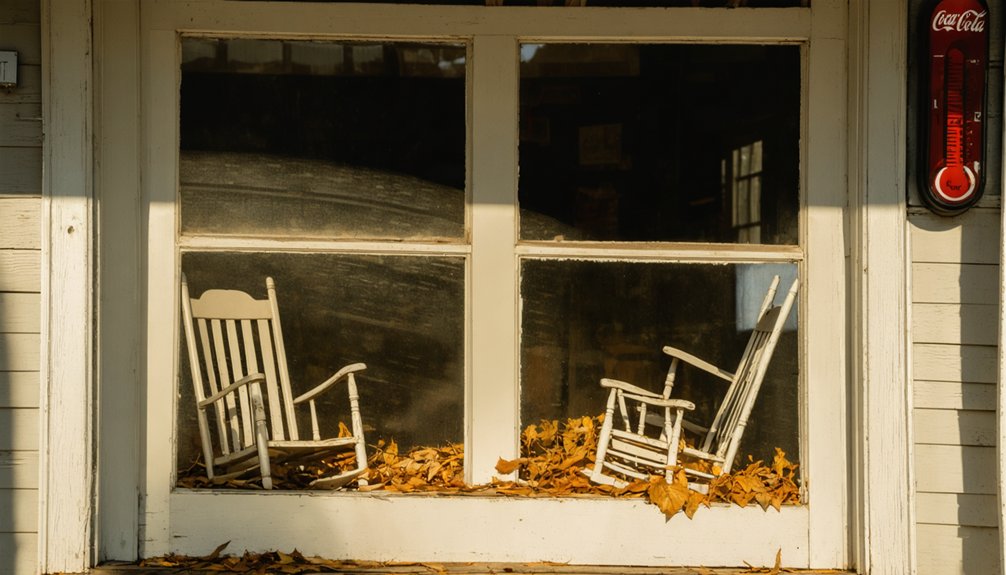
Life in rural Horace revolved around a delicate balance of self-sufficiency and community interdependence. You’d find families working their 120-180 acre farms, tending to diverse crops and livestock while maintaining vegetable gardens and orchards.
Daily routines centered on essential agricultural practices: men worked the fields and barns, while women managed households, preserved food, and tended to poultry.
Farm life followed strict gender roles: men handled fieldwork and livestock while women ran homes and managed the henhouse.
You couldn’t survive alone in Horace – community support proved crucial. You’d trade eggs and dressed chickens in town for groceries, and rely on traveling cobblers and blacksmiths for specialized services.
Your social life intertwined with work, from road-building to militia drills. The local church and general store served as community hubs, while your children attended the small rural school.
Every aspect of life demanded hands-on effort and neighbor cooperation.
The Quiet Fade: Understanding Horace’s Decline
You’d find the story of Horace’s decline mirrored in countless rural Illinois communities, where mechanized farming and shifting transportation routes gradually emptied the countryside of its people and purpose.
As farms grew larger and required fewer workers in the mid-20th century, young residents left Horace for urban opportunities, leaving behind aging buildings and dwindling services.
The town’s position one mile west of Illinois Route 1, coupled with its distance from rail lines, further isolated it from the economic lifelines that might’ve sustained its small but once-vibrant farming community.
Rural Exodus Impact
While many small towns across Illinois experienced gradual decline in the 20th century, Horace’s transformation into a ghost town exemplifies the devastating impact of rural exodus on America’s agricultural communities.
You’ll find that rural migration has hit hardest among younger residents, who’ve left in search of better opportunities elsewhere. Between 2010 and 2016, an astounding 85% of rural Illinois’ population loss came from out-migration rather than natural decline.
This exodus has eroded community resilience, leading to a cascade of closures – from the Horace Baptist Church to local businesses that once served as gathering places.
The remaining structures, like the old brick mercantile building, stand as silent witnesses to a once-vibrant community that’s now mostly forgotten on modern maps.
Agricultural Shifts Reshape Community
During World War II, sweeping agricultural changes transformed Horace’s farming landscape as mechanization revolutionized traditional practices.
You’d have seen corn acreage expand by 19% and soybean fields double in size as farmers adapted to meet wartime demands. Agricultural mechanization meant you could produce more with fewer hands, though you’d struggle with federal restrictions on machinery and fertilizer.
The face of your community changed dramatically as traditional barns became obsolete and small farmsteads disappeared.
You’d watch as your neighbors’ operations consolidated into larger industrial farms. The creameries and local processing facilities that once connected you to urban markets faded away.
This community transformation struck at Horace’s heart – as farming evolved, the town’s agricultural identity diminished, leaving behind empty storefronts and quiet streets.
Modern Legacy and Airport Development
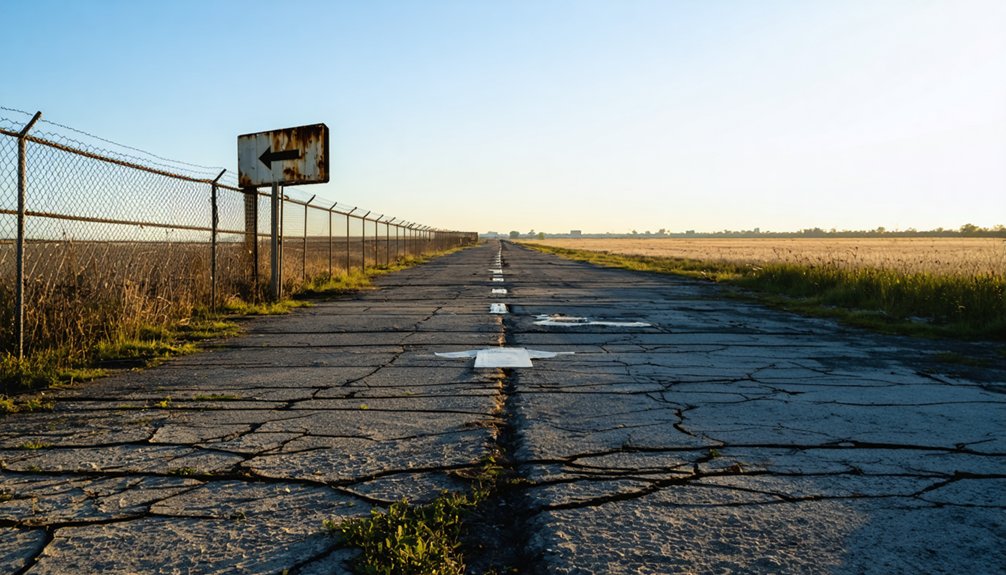
Although Horace, Illinois exists today only in historical records, its legacy lives on through the region’s modern aviation developments and proposals.
The ghost town of Horace, Illinois now serves as a foundation for ambitious aviation projects reshaping the region’s future.
You’ll find that airport economics have dramatically transformed this once-agricultural area, with proposed developments like Peotone airport promising new opportunities just 40 miles south of Chicago.
While community displacement remains a concern, the region’s transformation reflects broader changes in infrastructure and transportation.
- The proposed Peotone airport could revitalize the area where Horace once stood
- Local political leaders have shown bipartisan support for new aviation projects
- Environmental impact studies shape modern airport development decisions
- Former farmlands, like those in Horace, now face potential aviation-related rezoning
- You’ll see how abandoned regional airports provide cautionary tales for new developments
Frequently Asked Questions
Were Any Notable Crimes or Mysterious Events Reported in Horace?
After reviewing thousands of historical records, you won’t find any documented crimes, unsolved mysteries, or ghost sightings. The town’s decline was purely economic, leaving only abandoned buildings as silent witnesses.
Did Any Famous Personalities or Historical Figures Visit Horace?
You won’t find any documented famous visitors or evidence of historical significance through prominent figures in Horace. Its small farming community status and limited infrastructure didn’t attract notable personalities.
What Native American Tribes Originally Inhabited the Horace Area?
Like ancient guardians of the heartland, you’d find members of the Illinois Confederation, including the Cahokia, Kaskaskia, Michigamea, Peoria, and Tamaroa tribes, shaping the tribal history of this sacred land.
Were There Any Cemeteries Associated With the Settlement of Horace?
You won’t find documented cemetery locations directly tied to Horace, though local burial customs suggest there may have been small family plots that were later lost to development or farming.
Did Horace Residents Participate in Any Significant Civil War Activities?
Based on local history records, you’ll find that some Horace area residents joined Illinois regiments during the Civil War, including connections to both the 11th Massachusetts and 14th Illinois Cavalry.
References
- https://drloihjournal.blogspot.com/2022/09/lost-towns-of-illinois-horace-illinois.html
- https://www.heraldtimesonline.com/story/lifestyle/home-garden/2021/01/15/some-illinois-ghost-towns/43846097/
- https://www.ghosttowns.com/states/il/horace.html
- https://www.youtube.com/watch?v=nd3oyBaRkf8
- https://www.youtube.com/watch?v=mB6VhWMp8qw
- https://drloihjournal.blogspot.com/search/label/Lost Towns of Illinois
- https://en.wikipedia.org/wiki/List_of_ghost_towns_in_Illinois
- https://legendsofkansas.com/horace-kansas/
- https://kellycodetectors.com/content/pdf/site_locator_books/IL.pdf
- https://ohioghosttowns.org/hancock-county/
